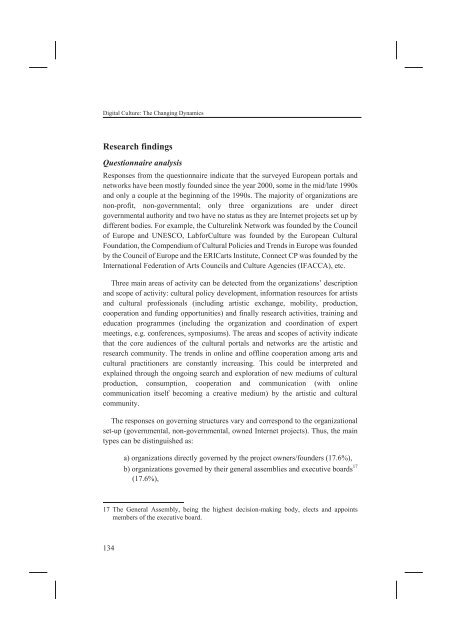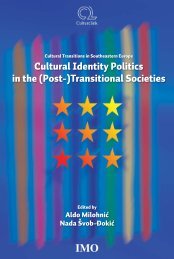D:\Documents and Settings\Ana\My Documents\Biserka-knjiga ...
D:\Documents and Settings\Ana\My Documents\Biserka-knjiga ...
D:\Documents and Settings\Ana\My Documents\Biserka-knjiga ...
Create successful ePaper yourself
Turn your PDF publications into a flip-book with our unique Google optimized e-Paper software.
Digital Culture: The Changing Dynamics<br />
Research findings<br />
Questionnaire analysis<br />
Responses from the questionnaire indicate that the surveyed European portals <strong>and</strong><br />
networks have been mostly founded since the year 2000, some in the mid/late 1990s<br />
<strong>and</strong> only a couple at the beginning of the 1990s. The majority of organizations are<br />
non-profit, non-governmental; only three organizations are under direct<br />
governmental authority <strong>and</strong> two have no status as they are Internet projects set up by<br />
different bodies. For example, the Culturelink Network was founded by the Council<br />
of Europe <strong>and</strong> UNESCO, LabforCulture was founded by the European Cultural<br />
Foundation, the Compendium of Cultural Policies <strong>and</strong> Trends in Europe was founded<br />
by the Council of Europe <strong>and</strong> the ERICarts Institute, Connect CP was founded by the<br />
International Federation of Arts Councils <strong>and</strong> Culture Agencies (IFACCA), etc.<br />
Three main areas of activity can be detected from the organizations’ description<br />
<strong>and</strong> scope of activity: cultural policy development, information resources for artists<br />
<strong>and</strong> cultural professionals (including artistic exchange, mobility, production,<br />
cooperation <strong>and</strong> funding opportunities) <strong>and</strong> finally research activities, training <strong>and</strong><br />
education programmes (including the organization <strong>and</strong> coordination of expert<br />
meetings, e.g. conferences, symposiums). The areas <strong>and</strong> scopes of activity indicate<br />
that the core audiences of the cultural portals <strong>and</strong> networks are the artistic <strong>and</strong><br />
research community. The trends in online <strong>and</strong> offline cooperation among arts <strong>and</strong><br />
cultural practitioners are constantly increasing. This could be interpreted <strong>and</strong><br />
explained through the ongoing search <strong>and</strong> exploration of new mediums of cultural<br />
production, consumption, cooperation <strong>and</strong> communication (with online<br />
communication itself becoming a creative medium) by the artistic <strong>and</strong> cultural<br />
community.<br />
The responses on governing structures vary <strong>and</strong> correspond to the organizational<br />
set-up (governmental, non-governmental, owned Internet projects). Thus, the main<br />
types can be distinguished as:<br />
134<br />
a) organizations directly governed by the project owners/founders (17.6%),<br />
b) organizations governed by their general assemblies <strong>and</strong> executive boards 17<br />
(17.6%),<br />
17 The General Assembly, being the highest decision-making body, elects <strong>and</strong> appoints<br />
members of the executive board.



